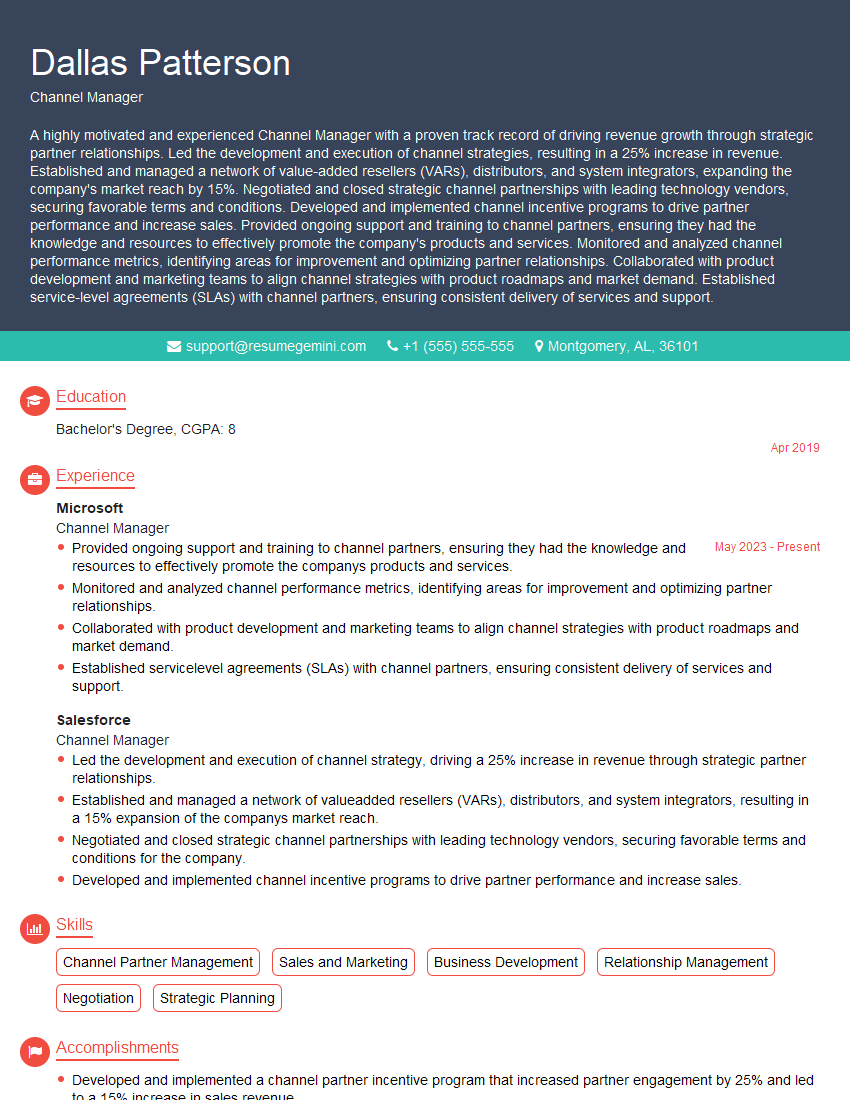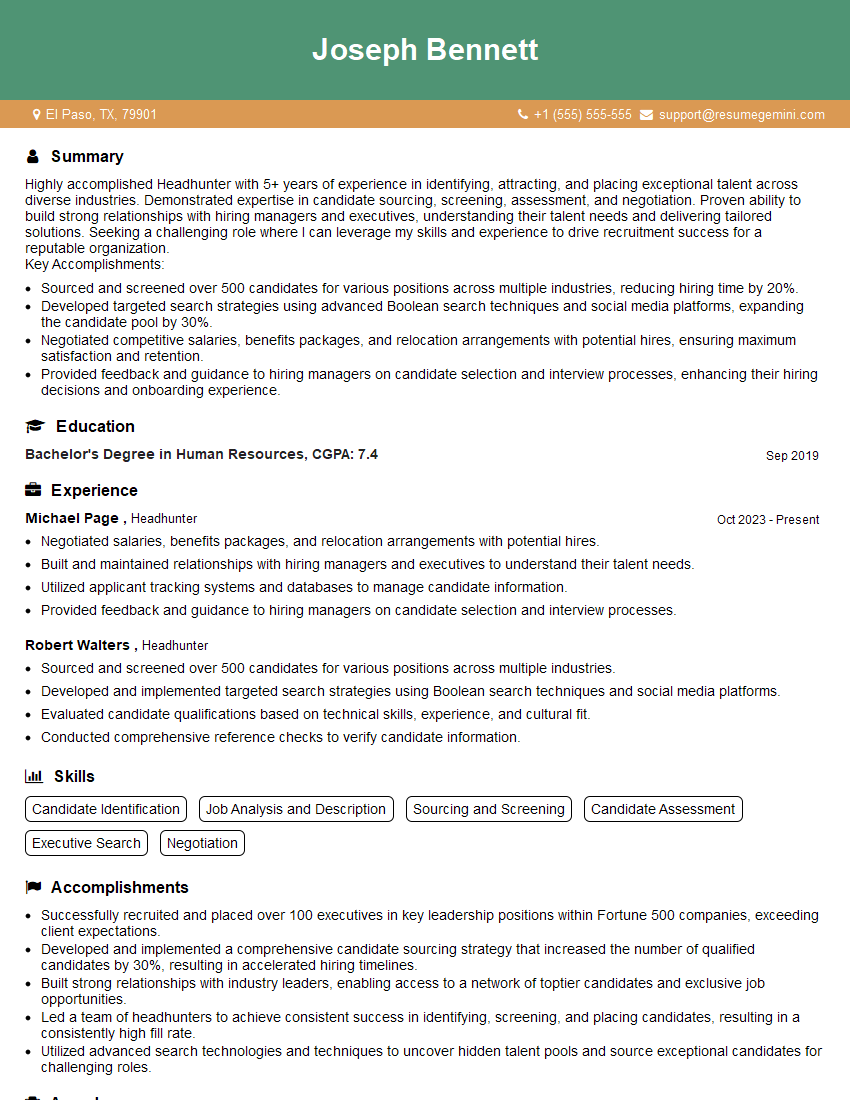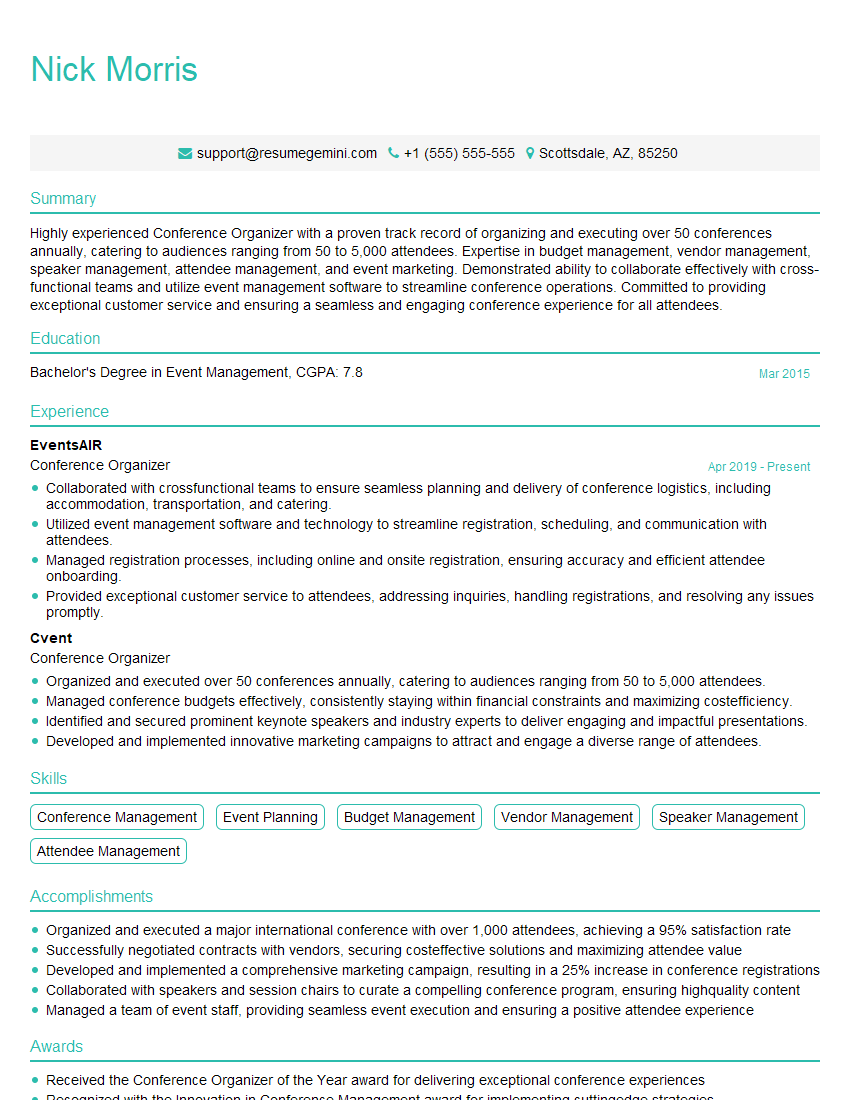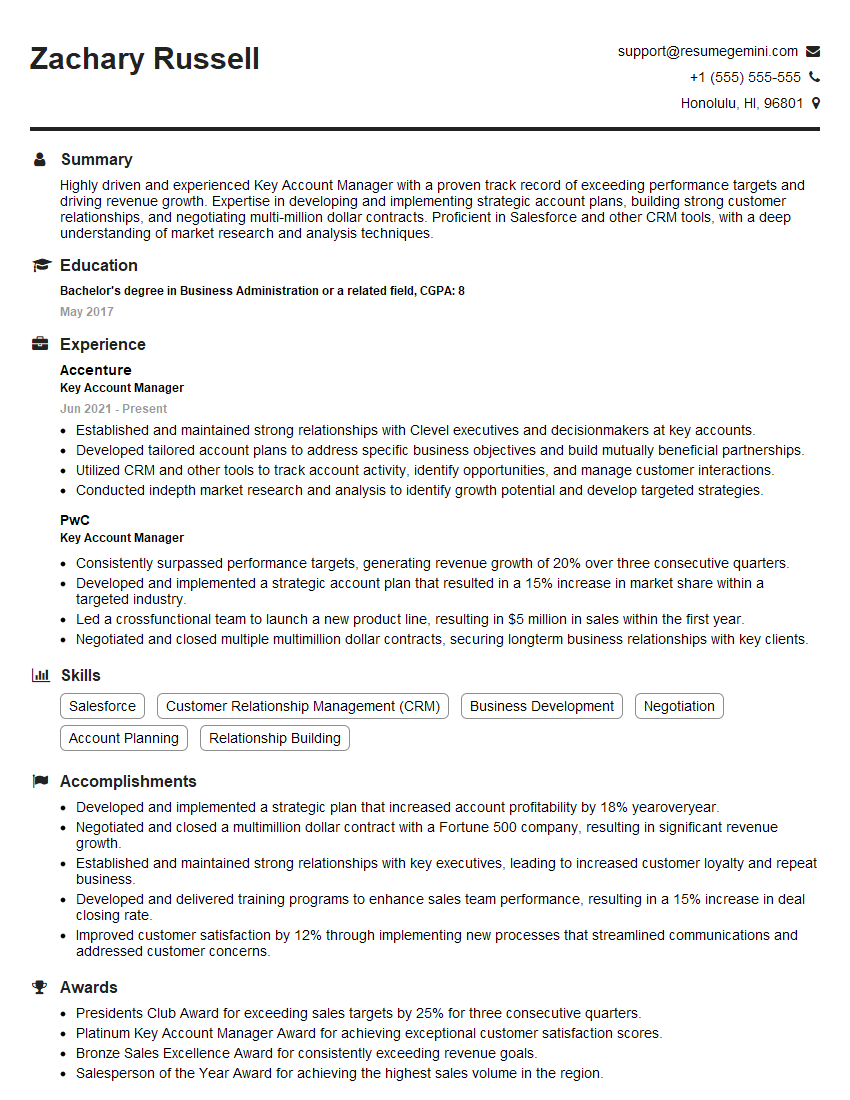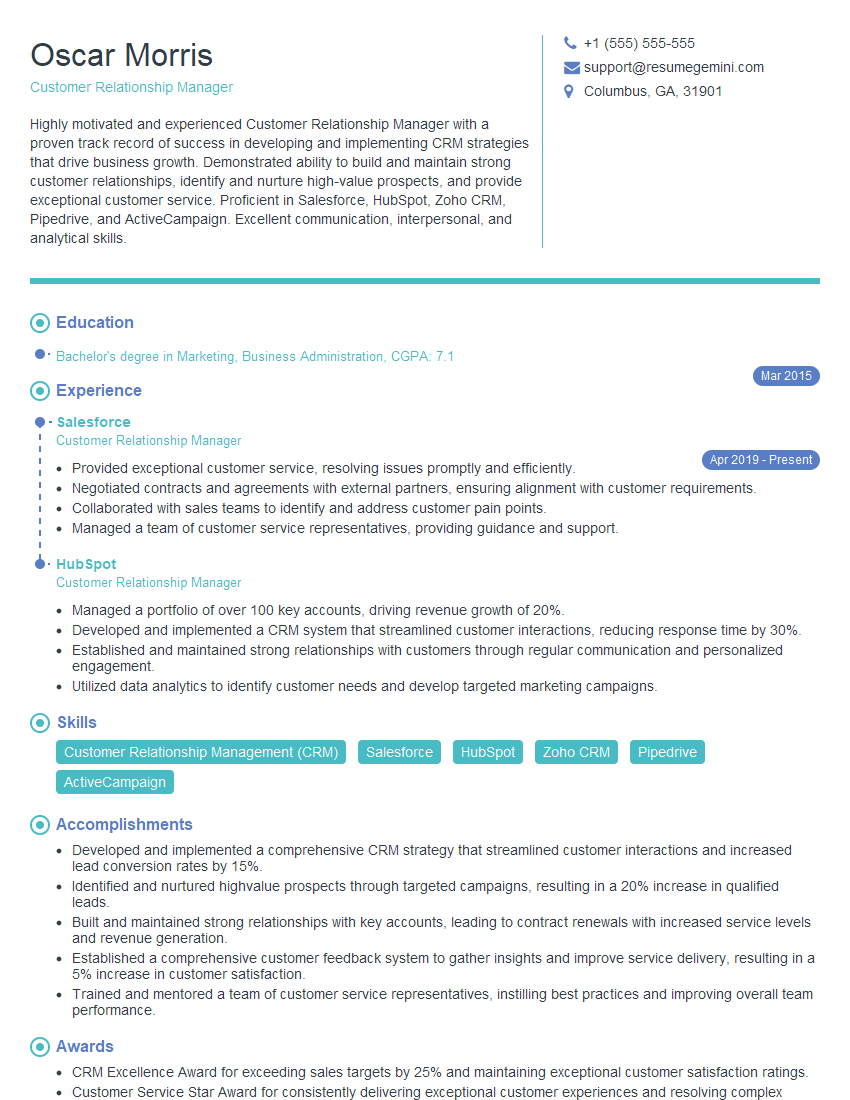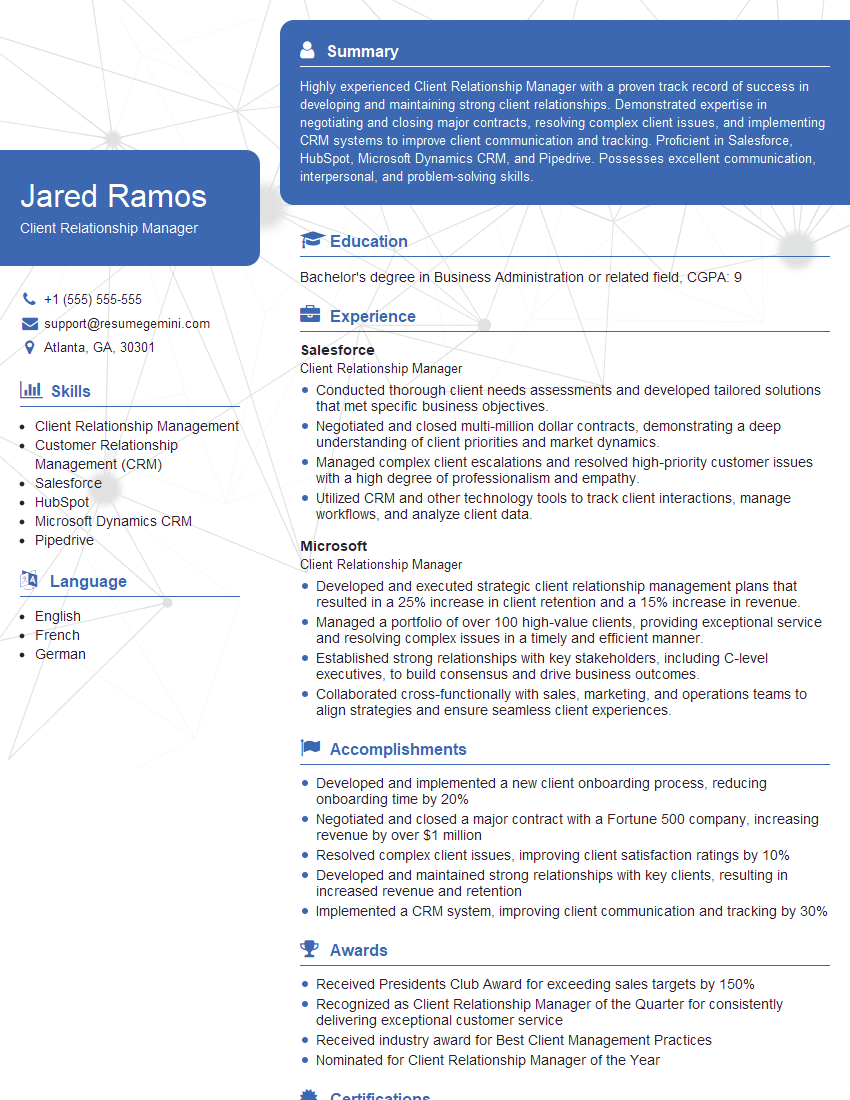Cracking a skill-specific interview, like one for Networking with Industry Professionals, requires understanding the nuances of the role. In this blog, we present the questions you’re most likely to encounter, along with insights into how to answer them effectively. Let’s ensure you’re ready to make a strong impression.
Questions Asked in Networking with Industry Professionals Interview
Q 1. Describe your approach to building and maintaining professional relationships.
Building and maintaining strong professional relationships is crucial for success in the networking field. My approach is multifaceted, focusing on genuine connection, consistent communication, and mutual value exchange. It’s not about collecting contacts, but cultivating meaningful partnerships.
- Genuine Interaction: I prioritize active listening and demonstrating genuine interest in others’ work and perspectives. I avoid transactional interactions and focus on building trust. This often involves asking thoughtful questions and remembering details about their projects or interests.
- Consistent Communication: I believe in staying in touch regularly, even if it’s just a brief email or LinkedIn message. This helps maintain relationships and ensures I remain top-of-mind when opportunities arise. This can include sharing relevant articles, congratulating on successes, or offering support.
- Mutual Value Exchange: I focus on how I can help others. This could involve sharing my expertise, making introductions, or providing assistance on projects. This reciprocal nature strengthens relationships and fosters a sense of community.
- Professionalism: Maintaining professional conduct and ethics is paramount. This involves prompt communication, respecting others’ time, and keeping commitments.
For example, after a conference, I’ll follow up with individuals I connected with, summarizing our conversation and offering to share resources mentioned. This consistent effort builds relationships over time.
Q 2. How do you identify key industry influencers and build rapport with them?
Identifying key influencers requires a strategic approach. I use a combination of online research and active networking to pinpoint individuals who are highly respected and influential within specific niches of the networking industry.
- Online Research: I leverage LinkedIn, industry publications, and relevant websites to identify individuals with significant experience, a strong online presence, and a history of thought leadership. I look for those consistently contributing valuable insights to the field.
- Active Networking: Attending industry events, conferences, and workshops offers valuable face-to-face interaction. Observing who people gravitate towards and who’s actively participating in discussions provides insights into key players.
- Building Rapport: Once identified, I build rapport by engaging with their content, participating in relevant conversations, and seeking opportunities for meaningful interaction. Offering genuine appreciation for their work or insights is crucial. I avoid overly promotional or self-serving approaches.
For instance, I might identify a leading expert on SDN (Software-Defined Networking) through their publications and LinkedIn activity. I’d then engage with their posts, comment thoughtfully, and eventually reach out directly with a genuine interest in their perspective on a specific topic.
Q 3. Explain your experience leveraging professional networking for business development.
Professional networking has been instrumental in my business development efforts. It’s a powerful way to discover opportunities, build partnerships, and expand my reach within the industry.
- Lead Generation: Networking events and online platforms frequently uncover potential clients and partners. Conversations often reveal unmet needs or opportunities that I can address with my expertise.
- Strategic Partnerships: Collaborating with other professionals expands my service offerings and introduces me to new markets. This collaborative model extends my reach and opens avenues for larger projects. For example, I partnered with a cybersecurity firm to offer joint solutions to clients seeking comprehensive network security.
- Reputation Building: Positive interactions and contributions within my network build credibility and generate referrals. My reputation precedes me, often resulting in inbound leads and opportunities.
In one instance, a connection I made at a networking event led to a project implementing a complex network infrastructure for a large enterprise. This would likely have been impossible without the initial connection.
Q 4. How do you manage your professional network using CRM or other tools?
I utilize a CRM (Customer Relationship Management) system to manage my professional network efficiently. This helps me track interactions, maintain consistent communication, and nurture relationships. I use features such as:
- Contact Management: I meticulously record contact details, including company information, key interactions, and notes from conversations. This ensures that I can easily recall relevant details when communicating.
- Interaction Tracking: I log every interaction – emails, phone calls, meetings – providing a comprehensive history of my communication with each contact.
- Segmentation and Targeting: The CRM allows me to segment my contacts based on various criteria (industry, location, interests), enabling targeted communication and tailored outreach. For example, I may create segments for potential clients, collaborators, and thought leaders.
- Workflow Automation: The CRM allows automated reminders for follow-ups, birthdays, and anniversaries, facilitating consistent communication and relationship maintenance.
Specifically, I use a system that integrates with LinkedIn and email, automating contact updates and streamlining my workflow.
Q 5. What strategies do you use to expand your network within a specific industry?
Expanding my network within a specific industry requires a targeted approach focusing on strategic engagement and continuous learning.
- Industry Events: I actively attend conferences, seminars, and workshops, selectively choosing events that align with my specific interests within the networking industry. This provides numerous opportunities for interaction with others in the field.
- Online Communities: Participating in online forums, groups, and communities (e.g., specialized LinkedIn groups) facilitates interaction and expands my reach beyond geographic limitations.
- Thought Leadership: Contributing to industry blogs, publications, or podcasts elevates my profile and attracts attention from like-minded professionals.
- Mentorship and Collaboration: Seeking mentorship from experienced professionals or collaborating on projects allows me to learn from others and expand my network organically.
For example, to expand my network in the area of cloud networking, I joined relevant online communities, attended cloud-focused conferences, and contributed articles to industry publications.
Q 6. How have you used networking to identify and secure new business opportunities?
Networking has been instrumental in identifying and securing numerous business opportunities. It’s often the critical link between my skills and client needs.
- Referral Networks: My established network frequently generates referrals from satisfied clients or connections who know of my expertise and capabilities.
- Uncovering Hidden Opportunities: Conversations with network contacts often reveal unadvertised or emerging needs within companies, leading to new business prospects.
- Strategic Partnerships: Collaborating with other professionals from my network opens doors to projects that would be inaccessible otherwise. This joint approach leverages our complementary strengths and expands our market reach.
Recently, a conversation with a former colleague led to a referral for a significant project involving network modernization for a financial institution. This exemplifies how strong relationships translate into tangible business opportunities.
Q 7. Describe a time you successfully navigated a challenging professional relationship.
I once faced a challenging relationship with a collaborator on a large network infrastructure project. We had differing technical approaches, leading to disagreements and project delays.
To navigate this, I first focused on understanding their perspective. I actively listened to their concerns, acknowledging their expertise while explaining the rationale behind my preferred method. We then established clear communication channels and defined roles and responsibilities to minimize ambiguity. We also agreed on a collaborative decision-making process that involved compromises from both sides. Ultimately, we developed a hybrid approach that incorporated elements from both our initial proposals, successfully completing the project on time.
This experience reinforced the importance of clear communication, empathy, and a willingness to compromise in professional relationships. It’s vital to address conflict constructively and focus on finding common ground for successful collaboration.
Q 8. How do you prioritize networking activities given limited time?
Prioritizing networking activities with limited time requires a strategic approach. Think of it like investing – you want the highest return on your time investment. I start by defining clear, measurable goals. What do I hope to achieve through networking? Is it to find a new job, secure partnerships, or learn about industry trends? Once I know my goals, I can prioritize activities that directly support them.
I use a combination of techniques:
- Prioritization Matrix: I categorize networking activities based on urgency and importance (Eisenhower Matrix). High-urgency, high-importance tasks, such as attending a key industry event, get immediate attention.
- Time Blocking: I dedicate specific blocks of time each week solely to networking, preventing it from being squeezed out by other tasks. This might include 30 minutes for LinkedIn engagement and an hour for reaching out to contacts.
- Targeted Networking: Instead of attending every event, I focus on those most relevant to my goals. This ensures my time is spent efficiently, maximizing my ROI.
For instance, if I’m aiming to break into the cybersecurity sector, I’d prioritize conferences focused on that area, and networking events specifically for cybersecurity professionals, rather than spreading myself too thin across various industries.
Q 9. How do you measure the effectiveness of your networking efforts?
Measuring the effectiveness of networking is crucial. It’s not just about the number of contacts but the quality of those connections and the tangible results. I track my efforts using several metrics:
- Number of meaningful conversations: I don’t just count contacts; I focus on interactions where I genuinely connected with someone and exchanged valuable information.
- Follow-up rates: A high follow-up rate indicates strong initial interactions and mutual interest. I track how many contacts I connect with after initial meetings.
- Lead generation: Did my networking lead to potential clients, partnerships, or job opportunities? This is a direct measure of success.
- Referral rate: Have my contacts referred me to others? This is a powerful indicator of the value of my network.
- Knowledge gained: Networking is also about learning. Did I gain valuable insights or information relevant to my goals?
I also regularly review my network to identify areas for improvement. Are my connections mostly passive, or are they actively engaging with me and my work? This qualitative assessment is as important as quantitative data.
Q 10. Describe your experience attending industry conferences or events.
I’ve attended numerous industry conferences, both large-scale events like RSA Conference and smaller, niche gatherings. My approach is always strategic. Before attending, I research the event’s agenda, identify key speakers and attendees, and create a plan for who I want to connect with.
At the event itself, I actively participate in sessions, ask insightful questions, and engage in conversations both during and after sessions. I don’t just collect business cards; I aim to have meaningful conversations, focusing on building rapport and finding common ground. For example, at a recent cloud computing conference, I connected with a solution architect who was facing a challenge similar to one I had solved, resulting in a valuable exchange of knowledge and a potential collaboration opportunity.
After the event, I follow up promptly with my new contacts, sharing relevant resources or articles and suggesting next steps. This post-event engagement is crucial to building lasting relationships.
Q 11. How do you utilize LinkedIn or other professional platforms for networking?
LinkedIn is a powerful tool for networking. I use it strategically, going beyond simply adding contacts. My approach includes:
- Content creation: I share valuable insights, articles, and opinions related to my field, establishing myself as a thought leader.
- Targeted engagement: I engage with posts and articles from people in my industry, joining relevant conversations and offering thoughtful comments. This helps me gain visibility and connect with others who share my interests.
- Group participation: I participate in relevant LinkedIn groups, contributing to discussions and building connections within the community.
- Personalized connection requests: I avoid generic requests. Instead, I personalize each request, referencing something specific I know about the person or their work.
- Profile optimization: My profile is complete, accurate, and professional, showcasing my skills and experience effectively.
I also utilize other professional platforms, like Twitter and specialized industry forums, tailoring my approach to each platform’s specific audience and purpose.
Q 12. What are some common pitfalls to avoid when networking?
Several pitfalls can derail networking efforts. The most common include:
- Focusing solely on self-promotion: Networking isn’t about pushing your own agenda. It’s about building genuine relationships.
- Being unprepared: Going into a networking event without a clear purpose or plan is ineffective.
- Poor communication skills: Inability to engage in meaningful conversations or follow up effectively undermines your efforts.
- Ignoring online presence: A poorly maintained or unprofessional online profile can negatively impact your networking success.
- Failing to follow up: Contacts are easily forgotten. Prompt and thoughtful follow-up is essential.
- Being too passive: Networking requires proactive engagement. Don’t wait for opportunities to come to you; actively seek them.
Avoiding these pitfalls requires careful planning, preparation, and a genuine interest in building relationships, rather than just collecting contacts.
Q 13. How do you tailor your networking approach to different industries or individuals?
My networking approach adapts to the specific industry and individual. When networking with someone in finance, my conversation might focus on market trends, regulatory changes, or investment strategies. However, when networking with a software engineer, the discussion might revolve around technological advancements, coding practices, or specific software tools.
Understanding the context is key. I research the industry and individual beforehand to identify common interests or shared goals, allowing me to initiate conversations that are both relevant and engaging. For example, when connecting with a potential client in the healthcare industry, I’d research their specific challenges and demonstrate how my services can directly address those needs.
This personalized approach demonstrates respect for the individual’s time and expertise, increasing the likelihood of a productive interaction and a lasting connection.
Q 14. How do you maintain long-term relationships with professional contacts?
Maintaining long-term professional relationships requires consistent effort and genuine engagement. It’s not just about staying in touch; it’s about nurturing the relationship.
My strategies include:
- Regular communication: I periodically check in with my contacts, sharing relevant articles, industry news, or simply acknowledging something interesting I’ve learned related to their work.
- Offering help: I assist contacts whenever possible, even if it’s a small gesture like providing information or making an introduction.
- Celebrating successes: I congratulate contacts on their achievements, demonstrating my genuine interest in their progress.
- Seeking advice: Requesting their insights demonstrates respect for their expertise and strengthens the connection.
- Utilizing CRM systems: I utilize CRM (Customer Relationship Management) systems to keep track of interactions, milestones and important dates to avoid forgetting crucial details about my professional relationships.
These actions reinforce the relationship, building trust and ensuring that the network remains active and valuable over time.
Q 15. Explain your experience leveraging your network to solve a complex problem.
During a critical network outage affecting a major client’s e-commerce platform, I leveraged my network to expedite troubleshooting and restoration. The problem was initially diagnosed as a routing issue, but standard diagnostic tools weren’t yielding the root cause. I immediately reached out to a former colleague, now a senior network engineer at a leading ISP, whose expertise lies in BGP (Border Gateway Protocol) routing. He provided invaluable insights into potential BGP configuration inconsistencies that were beyond our immediate team’s expertise. His guidance, combined with information I obtained from a network vendor contact I’d cultivated at a previous industry conference, led us to a misconfigured policy within the client’s BGP implementation. The issue was resolved within four hours, minimizing revenue loss and reputational damage. This highlights the importance of proactively building a diverse network of contacts across various disciplines within the networking field.
Career Expert Tips:
- Ace those interviews! Prepare effectively by reviewing the Top 50 Most Common Interview Questions on ResumeGemini.
- Navigate your job search with confidence! Explore a wide range of Career Tips on ResumeGemini. Learn about common challenges and recommendations to overcome them.
- Craft the perfect resume! Master the Art of Resume Writing with ResumeGemini’s guide. Showcase your unique qualifications and achievements effectively.
- Don’t miss out on holiday savings! Build your dream resume with ResumeGemini’s ATS optimized templates.
Q 16. How do you handle situations where networking contacts don’t lead to immediate results?
Networking is not always about immediate gratification. Sometimes, contacts may not have the specific solution, or their involvement might be delayed due to their own priorities. My approach in these situations involves maintaining consistent, professional communication. I express my gratitude for their time and consideration, and clearly explain the problem and any possible assistance they can offer, even if it’s just a referral. I follow up after a reasonable time frame, but avoid being overly persistent. I believe in nurturing relationships rather than solely focusing on immediate results. For example, I once reached out to a contact about a specific software issue; while they couldn’t directly help, they referred me to a specialist within their organization, ultimately leading to the resolution. This emphasizes the importance of treating every interaction as an opportunity to strengthen a relationship, even without immediate tangible results.
Q 17. Describe your experience with referral programs or other networking initiatives.
I’ve actively participated in various networking initiatives, including referral programs within my professional organizations and informal mentorship programs. In one instance, I participated in a referral program where I successfully recommended a candidate for a senior network architect role. Both the candidate and the hiring company benefited greatly; the candidate found a fulfilling career, and the company gained a highly skilled professional. This experience reinforced the value of proactive networking and the positive impact of leveraging my network to help others. Similarly, I’ve been involved in mentoring junior network engineers, guiding them through professional challenges and providing career advice. These reciprocal relationships strengthen my network and expand my professional reach.
Q 18. How do you differentiate between transactional and strategic networking?
Transactional networking focuses on immediate gains—a quick favor or information exchange. Strategic networking, however, cultivates long-term relationships built on mutual respect and shared value. Transactional networking might involve quickly asking a contact for a specific piece of information. Strategic networking would involve building a relationship with that contact over time, attending industry events, collaborating on projects, and offering assistance without always expecting something in return. While both have their place, strategic networking is far more sustainable and rewarding in the long run. It fosters trust and creates opportunities for mutual growth and support. It’s like the difference between buying a single item from a store versus building a genuine rapport with a trusted supplier.
Q 19. How do you leverage networking for career advancement?
Networking is instrumental in career advancement. It provides access to information about job opportunities, often before they are publicly advertised. My network has alerted me to several career opportunities, allowing me to proactively explore roles aligned with my goals. Furthermore, strong networking relationships can influence hiring decisions. Recommendations and endorsements from respected colleagues significantly increase my credibility. Moreover, networking expands my professional knowledge and skillset. Discussions and collaborations with peers expose me to new technologies and perspectives, enhancing my expertise and making me a more competitive candidate. Essentially, a strong network acts as a strategic advantage in my career journey, opening doors to opportunities and bolstering my professional standing.
Q 20. Explain your experience with different networking styles and approaches.
I’ve experienced a range of networking styles, from formal events like industry conferences to informal settings like online forums and mentorship programs. In formal settings, I focus on building professional relationships through structured interactions and targeted conversations. Informal settings allow for more organic interactions and deeper connections. Online forums provide a platform for collaborative learning and knowledge sharing. My approach adapts to the context; sometimes I proactively initiate conversations, other times I participate in discussions and contribute my expertise. Ultimately, my goal is to engage authentically and build mutually beneficial relationships, regardless of the networking platform. Each approach enriches my network in different ways.
Q 21. How do you manage competing priorities when balancing networking with other responsibilities?
Balancing networking with other responsibilities requires careful prioritization and time management. I utilize techniques such as time blocking to dedicate specific periods to networking activities. I also integrate networking into my existing routine; for example, I might connect with a contact during a lunch break or schedule a virtual coffee chat during a less demanding part of my day. Prioritizing tasks and setting realistic goals are essential. I focus on high-impact networking activities that align with my strategic objectives, ensuring that my efforts yield significant returns. This approach avoids feeling overwhelmed and allows me to maintain a healthy work-life balance while effectively leveraging my network.
Q 22. How do you ensure confidentiality and professional boundaries in your networking interactions?
Maintaining confidentiality and professional boundaries in networking is paramount. It’s about striking a balance between building rapport and respecting the sensitive information shared. Think of it like a carefully constructed garden – you nurture relationships but set clear limits to prevent overgrowth.
Confidentiality: I never disclose sensitive information about a company or individual without explicit permission. If someone shares a confidential project detail, I treat it as privileged information and only discuss it in relevant and appropriate contexts. For instance, if a contact shares their company’s upcoming product launch under strict confidence, I would never reveal this to a competitor or even on my personal social media. This builds trust.
Professional Boundaries: I am mindful of the context of our interactions. Networking events are for professional relationship building. I avoid crossing personal boundaries. For example, I won’t delve into deeply personal topics or engage in inappropriate conversations during professional meetups. I maintain a respectful distance while ensuring the interaction remains positive and productive. It’s about building a professional relationship, not friendship, within that context.
Data Privacy: I am always conscious of data privacy regulations. I avoid sharing contact details without consent and use secure platforms to exchange information.
Q 23. Describe a time you had to recover from a damaged professional relationship.
Once, I had a disagreement with a colleague that led to a strained professional relationship. We had differing opinions on a project strategy, and our communication became quite tense. I realized I had been too quick to judge and hadn’t fully understood his perspective.
Reflection: I took time to reflect on my own role in the conflict. I acknowledged my part in escalating the tension. This self-awareness was crucial.
Direct Communication: I scheduled a meeting to discuss the issue directly, emphasizing my desire to repair the relationship. I listened actively to his concerns, validating his feelings and avoiding defensive responses. I explained my point of view clearly and calmly.
Focus on Shared Goals: We shifted the conversation to focus on our shared professional goals. This helped us to see beyond our personal differences and work together towards a common objective. The project was successfully completed, and our relationship improved significantly.
Future Interactions: Since then, I’ve been more mindful of communicating clearly and empathetically, ensuring I understand different perspectives before reacting.
Q 24. How do you handle networking with individuals from different cultural backgrounds?
Networking across cultures requires sensitivity and adaptability. It’s not just about knowing the right handshake; it’s about understanding different communication styles and expectations. Consider it like learning a new language – you need to understand the nuances to truly connect.
Research & Awareness: Before networking with individuals from different cultural backgrounds, I research common customs and etiquette. This includes understanding greetings, appropriate conversation topics, and potential cultural sensitivities. For example, some cultures value directness while others prefer indirect communication.
Active Listening: I focus on active listening to understand their perspective and communication style. I pay attention to both verbal and nonverbal cues.
Respectful Communication: I communicate respectfully and clearly, avoiding jargon or idioms that might not translate well. I always use inclusive language and show genuine interest in their experiences and ideas.
Flexibility: I’m flexible and adaptable in my approach, willing to adjust my communication style to fit the situation and the individual’s preferences.
Q 25. How do you use networking to stay updated on industry trends and insights?
I leverage my network to stay updated on industry trends through a multi-pronged approach, ensuring I don’t rely on just one source. It’s about building a diverse ecosystem of information.
Industry Events: Attending conferences, webinars, and workshops allows me to hear directly from experts and learn about the latest advancements. These are excellent opportunities for both formal and informal networking.
Newsletters and Publications: I subscribe to relevant industry newsletters and publications to stay informed about the latest news and research. This provides a broad overview of the field.
Online Communities: I actively participate in online professional communities like LinkedIn groups, forums, and social media feeds related to my profession. This enables direct interaction with peers and experts.
Direct Contact: I reach out to my network contacts directly, engaging them in conversations and requesting their insights on specific trends or challenges. This is particularly effective for obtaining specific, actionable intelligence.
Q 26. How do you contribute to the success of your professional network?
Contributing to the success of my professional network is a two-way street. It’s about giving back as much as I receive. I believe in fostering a collaborative and mutually beneficial environment. Think of it as a symbiotic relationship.
Sharing Knowledge and Resources: I actively share relevant articles, insights, and resources with my contacts. I participate in discussions and offer assistance whenever possible.
Providing Introductions: I connect people within my network who might benefit from knowing each other. Building bridges and facilitating connections is incredibly valuable.
Mentorship and Support: I mentor junior professionals and offer support to those seeking advice or guidance. This helps both them and strengthens the overall network.
Active Participation: I actively participate in events and discussions, contributing my expertise and perspectives.
Q 27. Describe your experience with online professional networking communities.
My experience with online professional networking communities has been overwhelmingly positive. They’ve become invaluable tools for staying connected, learning, and advancing my career. However, like any tool, it’s important to use them effectively.
LinkedIn: I use LinkedIn to connect with colleagues, potential employers, and industry thought leaders. I actively participate in relevant groups, share insightful content, and engage in discussions. I focus on building a professional and well-maintained profile.
Specialized Forums and Groups: I’ve joined several specialized forums and online communities focused on specific areas of networking and technology. This helps me stay abreast of niche topics and engage with a more focused audience.
Strategic Engagement: I avoid spamming my connections with irrelevant content. Instead, I share thoughtful commentary, insights, and resources that provide value to others. My online interactions mirror my offline ones: professional, respectful, and helpful.
Q 28. How do you build trust and credibility with your professional contacts?
Building trust and credibility with professional contacts takes time and consistent effort. It’s about demonstrating your reliability, competence, and integrity. It’s a marathon, not a sprint.
Follow Through: I consistently follow through on my commitments and promises. This demonstrates reliability and builds confidence in my word.
Demonstrate Expertise: I actively showcase my expertise and knowledge through my work, contributions to online communities, and presentations. This establishes me as a reliable source of information and insight.
Authenticity: I am authentic and genuine in my interactions. People connect more easily with those who are genuine and transparent.
Active Listening & Empathy: I show genuine interest in others’ perspectives and experiences. This demonstrates respect and builds rapport.
Give Back: I proactively offer help and support to those within my network. This reciprocity fosters trust and strengthens relationships.
Key Topics to Learn for Networking with Industry Professionals Interview
- Professional Networking Strategies: Understanding different networking approaches (conferences, online platforms, informational interviews), and adapting your strategy for various professional settings.
- Building Rapport and Communication Skills: Mastering effective communication techniques, including active listening, concise self-introduction, and engaging conversation starters, tailored to industry professionals.
- Identifying and Targeting Key Individuals: Researching and identifying influential individuals within your target industry, understanding their roles and contributions, and crafting personalized approaches for connection.
- Leveraging Online Networking Platforms: Effectively utilizing LinkedIn and other professional platforms to build connections, participate in relevant discussions, and showcase your expertise.
- Following Up and Maintaining Connections: Developing strategies for thoughtful follow-up after initial interactions, nurturing relationships, and building a long-term professional network.
- Handling Difficult Conversations: Practicing responses to challenging situations, such as networking events where you feel uncomfortable or conversations that don’t progress as expected.
- Understanding Industry Trends and Insights: Demonstrating awareness of current trends, challenges, and opportunities within the networking and technology sector, showcasing your passion for continuous learning.
- Ethical Considerations in Networking: Understanding best practices for professional conduct, maintaining privacy, and navigating potential conflicts of interest in networking situations.
Next Steps
Mastering the art of networking with industry professionals is crucial for career advancement. A strong network opens doors to exciting opportunities, mentorship, and invaluable insights. To significantly increase your chances of landing your dream role, creating an ATS-friendly resume is paramount. This ensures your application gets noticed and considered by recruiters and hiring managers. We highly recommend using ResumeGemini to build a professional and impactful resume. ResumeGemini provides a user-friendly platform to create resumes tailored to specific industries, including examples specifically designed for candidates in Networking with Industry Professionals. Take advantage of this resource to present yourself effectively and confidently.
Explore more articles
Users Rating of Our Blogs
Share Your Experience
We value your feedback! Please rate our content and share your thoughts (optional).
What Readers Say About Our Blog
Hello,
We found issues with your domain’s email setup that may be sending your messages to spam or blocking them completely. InboxShield Mini shows you how to fix it in minutes — no tech skills required.
Scan your domain now for details: https://inboxshield-mini.com/
— Adam @ InboxShield Mini
Reply STOP to unsubscribe
Hi, are you owner of interviewgemini.com? What if I told you I could help you find extra time in your schedule, reconnect with leads you didn’t even realize you missed, and bring in more “I want to work with you” conversations, without increasing your ad spend or hiring a full-time employee?
All with a flexible, budget-friendly service that could easily pay for itself. Sounds good?
Would it be nice to jump on a quick 10-minute call so I can show you exactly how we make this work?
Best,
Hapei
Marketing Director
Hey, I know you’re the owner of interviewgemini.com. I’ll be quick.
Fundraising for your business is tough and time-consuming. We make it easier by guaranteeing two private investor meetings each month, for six months. No demos, no pitch events – just direct introductions to active investors matched to your startup.
If youR17;re raising, this could help you build real momentum. Want me to send more info?
Hi, I represent an SEO company that specialises in getting you AI citations and higher rankings on Google. I’d like to offer you a 100% free SEO audit for your website. Would you be interested?
Hi, I represent an SEO company that specialises in getting you AI citations and higher rankings on Google. I’d like to offer you a 100% free SEO audit for your website. Would you be interested?
good



